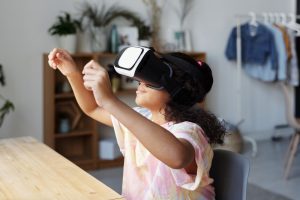 Fortunately, education is progressing to become more inclusive of those with different learning styles and educational needs, but there is still a lot that can be done to make the classroom more inclusive for each and every student. It is becoming more and more apparent that it is time we rethink not just what we teach, but exactly how we teach.
Fortunately, education is progressing to become more inclusive of those with different learning styles and educational needs, but there is still a lot that can be done to make the classroom more inclusive for each and every student. It is becoming more and more apparent that it is time we rethink not just what we teach, but exactly how we teach.
One medium that could provide learning support for students with special needs in the near future is the use of augmented reality (AR) in education.
This technology can break down barriers in a learning environment.
AR is beneficial as it overlays virtual images onto real world images in real time. It allows students to see, hear and touch the knowledge in a fun and engaging way. In addition, educators may be able to create personalized learning plans by studying AR users’ data, thus allowing the educator to tailor lessons to a student’s specific needs and subsequently allowing them to access the best ways to motivate their student.
Many AR apps are easily accessible, inexpensive, and can be used anywhere at any time. They also have the ability to allow students to retain information much better than standard lessons due to them being interactive and fun.
To give some examples, students who struggle with coordination may benefit from being able to interact with 3D shapes and pictures showing geographical locations, which also had the added benefit of exposing children to different cultures, landscapes, and environments.
Research also suggests that, for students with cochlear, hearing or speech impediments who use smartphone technology or headsets that incorporate AR platforms, the learning gap narrows when it comes to their ability to converse, communicate, and understand.
Outlets such as the Augmented Classroom by CleverBooks, which features content that focuses on STEM, could similarly be used to help students who may struggle from math-based issues, such as dyscalculia. Other apps can also let students experience the wonders of space and to navigate the galaxy without needing to leave their seats.
Language apps can be applied through AR, which in turn can help a student improve both fluency in another language and pronunciation of words in different languages.
Overall, it is apparent that this is the one of, if not the best, tool that a teacher in the 21st century can employ in order to engage their pupils of all learning abilities and learning styles in their lessons. Although it has only been around for less than two decades, it is nevertheless evolving at a rapid rate and is constantly being improved on across all areas.
For parents, educators, and students alike, it is important that we empower students, especially students with special needs, to reach their full potential, regardless of their academic abilities. Early intervention and exposure to AR is key to their successful inclusion into society.
Excerpted from “How AR Can Help Students With Special Needs” in eSchool News. Read the full article online.